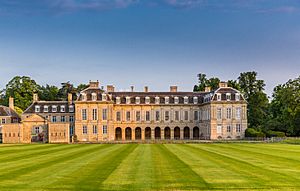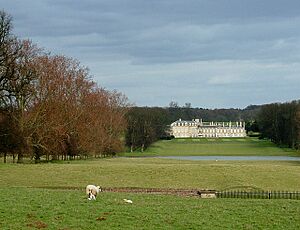Boughton House facts for kids
Boughton House is a grand country house in Northamptonshire, England. It is located near Kettering and sits on a very large estate. This amazing house is famous for its beauty and its old collections. It has stayed almost the same since the 1600s! People sometimes call it The English Versailles because it looks like a French castle.
The house was built by Ralph Montagu, 1st Duke of Montagu after he inherited the land in 1683. He had been an ambassador to France and loved French architecture. He wanted Boughton House to look like the grand palaces he saw there, especially the Palace of Versailles.
Today, Boughton House is one of the homes of Richard Scott, 10th Duke of Buccleuch. It holds many treasures from three important families: Montagu, Douglas, and Scott. These families came together through marriage. Inside, you can find beautiful furniture, tapestries, and paintings. There is also a special armoury with a collection of old weapons. Boughton House is open to visitors on certain dates for guided tours. It also hosts events like weddings.
Contents
History of Boughton House
The original building at Boughton was a monastic (monk's) building. In 1528, Sir Edward Montagu, a top judge for King Henry VIII, bought it. He started turning it into a large home.
Most of the house you see today was built by Ralph Montagu, 1st Duke of Montagu. He took over the house in 1683. Ralph Montagu had spent time as an ambassador in France. He was very inspired by French buildings and gardens. This is why Boughton House has such a strong French style. He even worked with many skilled craftspeople from France.
His son, John Montagu, 2nd Duke of Montagu, did not change the house much. However, he made big changes to the gardens and the land around the house. He did this after returning from military campaigns in Europe.
After the 3rd Duke of Montagu passed away in 1790, the house went to the Dukes of Buccleuch family. This happened through the marriage of his daughter, Elizabeth. From the mid-1700s, Boughton House was not used or changed very often. But it was always well looked after. Because of this, it has some of the best-preserved baroque (a fancy style from the 1600s and 1700s) rooms in Britain.
In the late 1900s, Mary ("Mollie"), Duchess of Buccleuch, lived at Boughton. She helped bring the house back to life. After she passed away in 1993, the 9th Duke started opening Boughton for small tours. Now, the house is open to the public for guided tours for a few weeks each year.
Amazing Collections
Boughton House is home to an incredible collection of items. These include furniture, tapestries (woven wall hangings), porcelain, and carpets. The art collection is also very special.
You can see famous paintings like The Adoration of the Shepherds by El Greco. There is also a portrait of Mary Montagu by Thomas Gainsborough. A series of grey-toned paintings called grisailles by Van Dyck are also on display. Another notable painting is Breaking Cover by John Wootton.
The armoury at Boughton House used to be a servants' hall. Now, it holds one of the best private collections of armour in the country. This historic collection was greatly improved by John, the 2nd Duke of Montagu.
The Grand Gardens
The gardens at Boughton House match the French style of the house. They are very formal and geometric. There are huge areas of grass, reflecting water, and long lines of trees. These designs create a peaceful and thoughtful landscape. They show ideas from the Age of Enlightenment, where people believed gardens could be a journey for the mind.
The 2nd Duke, nicknamed John The Planter, removed older garden beds. He planted many avenues of elm and plane trees. He also made the water features a key part of the garden's design. Later, a famous landscaper named Charles Bridgeman is thought to have created the sculpted earth shapes.
Work to restore the garden began with the 9th Duke and continues today. One project involved making the River Ise its 18th-century width again. In 2009, a new artwork called Orpheus was added. It is named after a musician from Greek mythology. This striking landform includes a large inverted pyramid and a spiral stream.
In 2015, a large lake called The Grand Étang was recreated. This lake is almost one acre in size and has a 75-foot tall water jet. It reflects the main front of Boughton House, just as it did in the early 1700s. This lake was also used for ice-skating in the winter.
Recent Events at Boughton House
In 2012, some unknown musical scores were found in the Montagu Music Collection at Boughton. These included music by the famous Italian composer Antonio Vivaldi.
Since 2014, Boughton House has been the home of the Greenbelt festival. This is a festival of arts, faith, and justice held every year in England.
Boughton House has also been used as a filming location for movies. These include Les Misérables (2012) and Napoleon (2023). It was also featured in the TV show An American Aristocrat's Guide to Great Estates (2020).
See also
- Montagu House, Bloomsbury – the 1st Duke of Montagu's London house
- Drumlanrig Castle – also owned by the Duke of Buccleuch
- Dalkeith Palace – also owned by the Duke of Buccleuch
- Bowhill House – also owned by the Duke of Buccleuch
- Treasure Houses of Britain – a 1985 TV series partly filmed at Boughton




